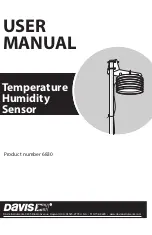
nVent RAYCHEM Elexant 4010i/4020i User Manual
RAYCHEM-AR-H60624-40X0iOpsManual-EN-1905
nVent.com
|
35
3.5.3
Alarm Sources
The monitored process parameters trigger an alarm if they move beyond the defined setpoints.
Important events that impact the function of the device, will also trigger alarms. The table below
describes the conditions that trigger each type of alarm.
Main Screen Page
Alarm Source
Description
Control
Setup
Control Temp
Control Temperature High
The control temperature is above the control high
temperature setpoint.
Control Temperature Low
The control temperature is below the control low
temperature setpoint.
Control Temperature Failure
There is no valid control temperature reading.
Output Limiting Output Limiting
The output duty cycle is being limited due to the
load power or current being higher than the power or
current limit setpoint.
SSR Overcurrent (Line
x
)
The output is off because the measured current has ex-
ceeded the SSR rating for an extended period of time.
Circuit Breaker Limiting
The output duty cycle is being limited because the
measured current exceeds the circuit breaker
time-current curve.
Load Shedding Load Shed Comm Failure
The load shed source communication has timed out.
Misc.
Contactor Count
The number of contactor cycles has exceeded the
cycle count setpoint.
Heater On Time
The heater on time has exceeded the heater
ON time setpoint.
External Input
The Digital Input is configured to Alarm and an alarm
condition has been triggered.
Temperature Temp Sensor
x
Temperature Sensor
x
High
Sensor
x
’s measured temperature exceeds the sensor
high temperature setpoint.
Temperature Sensor
x
Low
Sensor
x
’s measured temperature is below the sensor
low temperature setpoint.
Temperature Sensor x Failure Sensor
x
is not indicating a valid temperature.
Temp Limiting
High Limit Cut-out
The output is turned off because a temperature sen-
sor is above the high limit cut-out setpoint.
Low Limit Cut-out
The output is turned off because a temperature sen-
sor is below the low limit cut-out setpoint.
Electrical
Trace Current
High Trace Current (Line
x
)
The measured trace current exceeds the high
current setpoint.
Low Trace Current (Line
x
)
The measured trace current is below the low
current setpoint.
Ground Fault
High Ground Fault
The measured ground fault current exceeds the high
GF setpoint.
Ground Fault Trip
The output is off because the measured ground fault
current exceeds the GF trip setpoint.
Ground Fault CT Failure
There is a problem with the controller’s internal GF
sensing circuitry.
Trace Voltage
High Trace Voltage
The measured voltage exceeds the high
voltage setpoint.
Low Trace Voltage
The measured voltage is below the low
voltage setpoint
Trace
Resistance
High Trace Resistance (Line
x
) The calculated trace resistance exceeds the high
resistance setpoint.
Low Trace Resistance (Line
x
) The calculated trace resistance is below the low
resistance setpoint.
















































